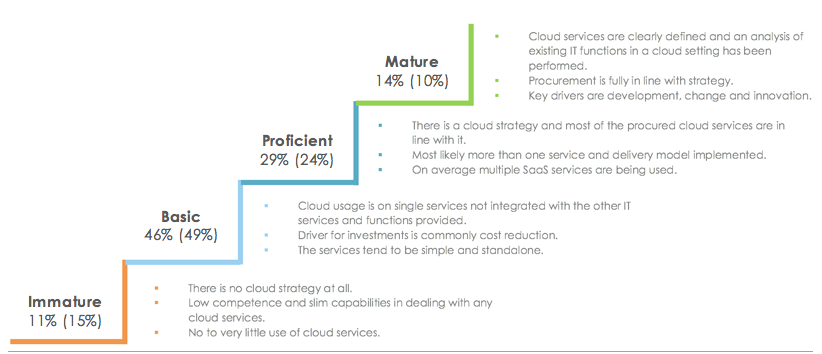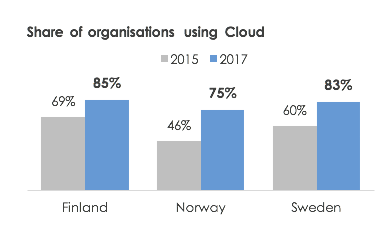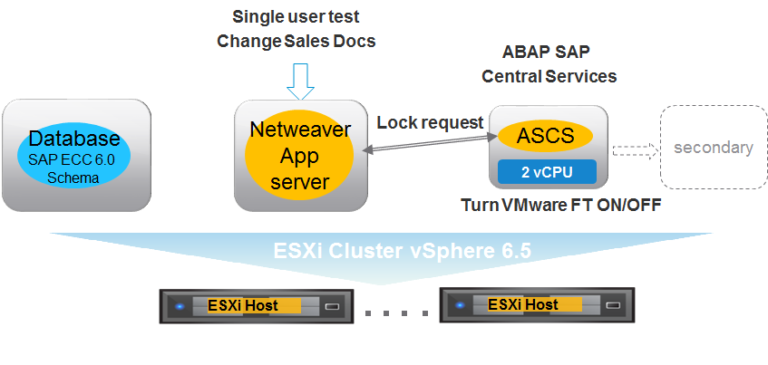Cloud-based services are a relatively new field for many businesses across the globe. Regardless, many organizations are rushing to adopt these solutions. There are some key reasons why. First, these cloud services help relieve internal expenses by offloading the need to adopt, upgrade and maintain the necessary IT infrastructure. Second, these solutions provide clients with affordable access to cutting-edge computetechnology. This enables businesses to remain competitive, even if they lack the same IT resources and budgets their competitors enjoy. Third, cloud-based services provide organizations with an agile and flexible infrastructure that easily scales with growth and provides access to global regions some businesses simply couldn’t access before.
Still, extracting the most value out of cloud services takes time, talent and experience. Organizations who were early cloud adopters have a head-start, and enjoy a level of cloud maturity their competitors do not. However, this maturity gap is closing. A recent report by IT research firm Radar, produced on behalf of VMware and Tieto, examines how this gap is closing amongst businesses in three Scandinavian countries — Finland, Norway and Sweden.
The report explores how cloud maturity has changed in these three countries within a two-year period from 2015 to 2017. The change over this short period has been remarkable. For example, strategic maturity across these countries grew by 33 percent while operative maturity grew by 13 percent. Businesses previously labeled as “immature” in cloud dropped by 15 percent. Only 11 percent of organizations surveyed remain in the “immature organizations” category.

What Makes for Maturity in the Cloud
But what makes for a “cloud mature” organization? There are no hard and fast definitions of a cloud mature organization, but there are indicators. For example, the survey found that proficient and mature organizations tend to have a well-defined cloud strategy, and acquire and use cloud services to buttress that strategy. Organizations also tend to deploy more than one cloud service within their organization, and have a keen understanding of what each service is capable of providing. Mature organizations, too, tend to procure solutions directly in line with their strategy and are driven by development, change and innovation within their respective industries. 
In 2015, the share of organizations using cloud technologies in Finland, Norway and Sweden were 69, 46 and 60 percent, respectively. Those figures changed to 85, 75 and 83 percent, respectively, in early 2017. Other significant changes took place over the two-year period. Organizations in the three countries diversified their cloud services, readily blending private, public and hybrid clouds in complex and business-critical areas. One type of cloud, the public cloud, grew as the favored model amongst the three countries, and now make up 51 percent of total cloud spend in Finland, Norway and Sweden. Radar’s report suggests this trend will continue for the next few years.
Cloud’s Perfect Storm
Radar found there are number of factors contributing to this rapid growth in cloud use across the surveyed countries, each dynamically interacting with one-anther in the “perfect storm” of cloud adoption. The first is competition from the global market. The low cost of skilled labor in APAC countries puts pressure on countries, particularly those in Scandinavia, with high-cost economies. This pushed many Scandinavian businesses to find new ways to remain competitive, particularly by cutting cycle times through digital initiatives.
These digital initiatives, too, were pursued right as several digital breakthroughs made their way into the market. Cognitive platforms, artificial intelligence, virtual and augmented reality and more innovations are enabling — or on the cusp of enabling — new means of discovering and communicating new business processes and models while perfecting old processes. This explosion of digital initiatives will likely continue for some time, encouraging competition and innovation in the global marketplace.
Finally, the market places in these three countries experienced a rapid industrialization of their respective IT industries. Again, the global marketplace was a significant factor as businesses like Google, IBM and Amazon were able to provide smaller businesses with virtual IT infrastructures that could scale with the business. While these global “cloud factories,” as Radar calls them, have an outsized impact on Scandinavian IT infrastructures, regional and local players are maturing and growing by filling in the advisory and location gaps these larger players miss.
The Benefits Realized
These factors have combined and catalyzed cloud adoption in each country. The effects have been tremendous. Cloud mature organizations, which constitute 14 percent of surveyed organizations, average 21 percent lower costs in IT operations, according to Radar’s findings. Responding organizations also say they have a 29 percent larger share of IT spend they can dedicate to pursuing innovative solutions. Mature organizations also rate their ability to support digitalization in the core of their business 19 percent higher than others. They also rate their ability to support innovation and increase business competitiveness as being 16 percent higher than others, as well.
The benefits of industrial cloud adoption across these three countries will compound as time wears on. Skilled workers will continue to emerge and experience in exploring, pursuing and deploying flexible, agile solutions will grow. But these benefits will take time to realize. Again, only 14 percent of responding organizations are rated as “cloud mature.” But those who are at the mature or proficient level will find themselves more prepared and capable of accommodating and adapting to the disruptive nature of today’s new digital technologies.
Interested in reading the full report? Download The Benefits of Cloud Maturity: Cloud Maturity Index 2017 today. And don’t forget to join in on the conversation at Twitter and like the VMware Service Provider page on Facebook.






